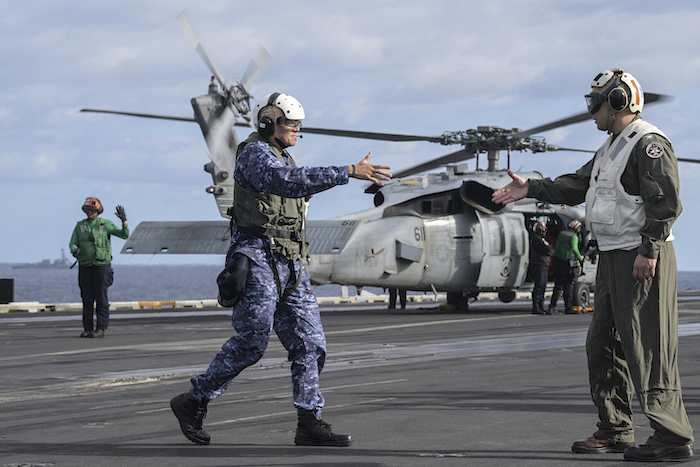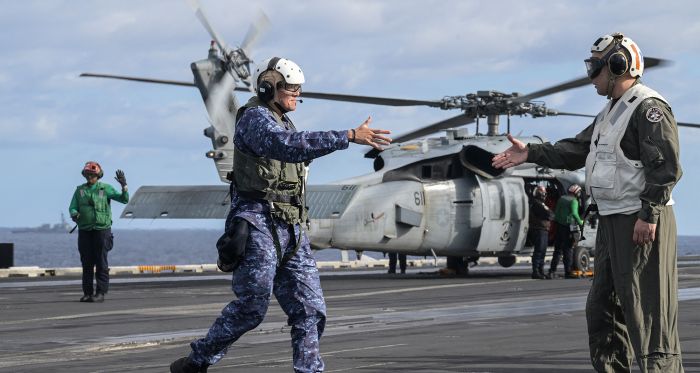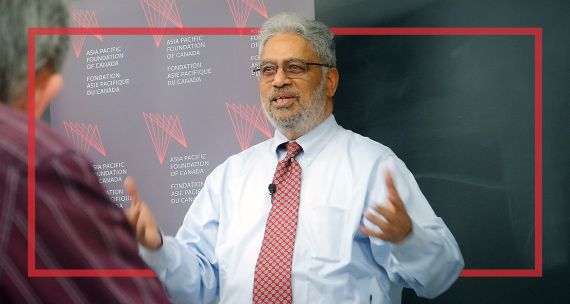The following are remarks given by Professor Yves Tiberghien at an event co-hosted by APF Canada and the Royal Canadian Navy’s Maritime Forces Pacific on June 27, 2024, titled “Canada’s Contribution to Peace and Security in the North Pacific.” Professor Tiberghien was based at the Taipei School of Economics and Political Science (at National Tsinghua University in Hsinchu, Taiwan) as Visiting Scholar from September 2023 to June 2024, where he engaged in a wide range of discussions in the region, including about peace and security issues.
In the current moment we are witnessing a rapidly changing geopolitical environment, with several dangerous hot spots and an acceleration of tit-for-tat dynamics.
The prime movers in this situation are China and the U.S., each animated and constrained by their domestic politics that sometimes limit their ability to deeply understand each other and engage in strategic, long-term calculations. The moves that each of them makes – which are usually framed as being defensive and reactive – are feeding a cycle of interactions that is transforming the region.
Russia’s war in Ukraine and its complex global interactions is a secondary driver, with major impacts on energy and food security. Additionally, Putin’s strategic visits to North Korea and Vietnam in June, and the arrangements that resulted from these meetings, have deepened linkages in the Indo-Pacific beyond the China-Russia partnership.
The third force impacting the region now is the war in Gaza, which has tilted Indonesia and Malaysia away from the U.S. and closer to China.
All middle powers in the region are actively adjusting their postures and strategies, as they respond to this new security and economic environment. A major question for the coming years will be this: Can middle powers innovate and cooperate to help stabilize deterrence in the region?
For Japan and Korea, the current changes are historic. Japan, under a supposedly “dovish” prime minister, is undergoing the biggest military strengthening and security adjustment since the Second World War. That includes a doubling of its military budget relative to gross domestic product (GDP) (from 1% to 2% over five years) and military deployments across islands south of Okinawa’s main island. At the same time, Japan’s military, along with the militaries in South Korea and Taiwan, are facing recruitment challenges and public sentiment that does not support taxation to pay for increases in security spending.
Seven Key Trends
Overall, seven trends are shaping the Indo-Pacific’s new security situation.
1. Great power transition
The rise of China, as well as the rise of other emerging powers (India, Indonesia, and the Association of Southeast Asian Nations (ASEAN)), is a game changer. According to IMF data, the percentage of China’s GDP to that of the U.S. increased from 12 per cent in 2000 to 40 per cent in 2010, and then further to 76 per cent in 2021, before tapering off at 65 per cent as of 2023 (largely due to shifts in the exchange rate).
This is only an indicator of a shift in economic power; the U.S. remains the dominant military and financial power. However, this is indicative of a major period of great power transition, a partial hegemonic transition that dominates everything else in the region and sets up the so-called Thucydides trap. As is well established in the field of international relations, a rapid shift between the #1 and #2 great powers creates incentives for the established power to push back in every possible way against the rising power (which is perceived as a threat, no matter what kind of political regime it has) and for the rising power to take various actions to gain more space in a system set up by the established powers. This sets up a process of building pressure, similar to the pressure that builds up beneath tectonic plates.
For the U.S., maintaining the global order means maintaining U.S. dominance, whatever the cost. The incentives make it tempting for the U.S. to launch either a preemptive strike or to overwhelm its rival (China) with dominant power mobilization, even at the cost of infinite risk. Can the U.S. avoid such temptation?
For China, rising within the existing order still requires it to gain space in that order. When it faces or anticipates pushback, China will challenge the existing order. The dynamic also empowers more nationalist and aggressive actors within the Chinese system who are ready to take more intrusive measures (as experienced by Canada). Can China avoid triggering a conflict that would greatly undermine its rise?
For middle powers, the Thucydides trap complicates everything. Can these middle powers differentiate pushing back against Chinese assertiveness toward them from more dangerous hegemonic plays that could easily engulf them?
2. Interactive Cognitive Frames and Cycles of Misperception
The current dynamics are not just a matter of interests and power. They involve emotions, cognitive frames and beliefs, ideologies, and ideas. Both sides present the growing conflict as a moral conflict of good vs. evil, overlooking in their own strategic thinking the reality of the Thucydides trap. These ideas are reinforced by political entrepreneurs and through social media, generating echo chambers and bubbles.
For the U.S., it is about defending the Liberal International Order, which includes power arrangements, institutions, and norms. It is also about defending the U.S.’s moral role as leader of that order and pushing back against the Chinese Communist Party.
For China, it is about defending its rightful right to return to the position it occupied from 200 BC to 1800, namely, to the centre of the East Asia international order and as the generator of regional norms and political thought. It is also about erasing nearly two centuries of civil war, decay, and colonization by the West and Japan. This generates very powerful emotions of resentment and recovery of identity.
The heavy weight of emotions and historical narratives in forming positions has two major drawbacks. First, it generates hubris and over-confidence on both sides. The U.S. and China currently overestimate their own position (based on their belief in their own moral case) and downplay that of their opponent (based on its perceived flaws). Both sides have bottom lines and ideological views. But this blurs the capacity to squarely assess capabilities and to develop strategies that can anticipate not just one cycle of interaction but thousands of tit-for-tat moves and the eventual endpoint. Morality is not about being morally right in absolute terms but rather about being right in the real world. Morality is about generating a better world for most humans and not entering into an unending cataclysm.
Second, both sides increasingly think in terms of loss aversion, which, in turn, generates a greater willingness to take risks (according to prospect theory). Interactive loss-aversion dynamics are particularly prone to escalation. The U.S. and its allies believe they are protecting the existing liberal order. China, meanwhile, thinks it is protecting its rise and its historic position at the heart of the East Asian system. Both sides thus think in terms of their bottom line and red lines.
This is how key European leaders thought in July 1914. That year, those leaders collectively walked into a disaster, but they did so rationally, in the defence of their bottom lines and values.
In such situations, it is critical to make credible evaluations and calculate interactions and outcomes over multiple interactions in the interest of affecting the eventual outcome of the interactions.
3. The Spread of Non-Strategic Domestic Politics in Key Countries
Today, most countries are caught in a cycle of rising inequality, political polarization, and weak or insecure leadership with short-term priorities. This is probably due to the lack of governance of globalization and new technologies, as well as the polarization of ideas amplified by social media. At the centre of the global system is the U.S., which is more polarized and divided than at any time since 1860 and on the brink of major democratic recession and instability.
China also has its own domestic troubles. Despite great power centralization around President Xi Jinping and the erosion of Deng Xiaoping-era institutional reforms, factions are still struggling, and many decisions are surprising or opaque. In fact, some decisions, such as the border war with India in May 2020, the overwhelming sanctions of March 2021 on EU parliamentarians that killed China’s own hopes of ratifying the EU-China Comprehensive Agreement on Investment, or the intense hardening of relations with the Philippines, are strategically irrational when we consider the relationship of benefits vs. the astronomical costs incurred by China. These actions can only be explained in terms of domestic struggles among groups within the Chinese elite. The rationale of a sub-state actor or a political actor locked in a struggle for power often does not generate state-level rationality.
We also note that South Korean President Yoon Seok Yeol and Japanese Prime Minister Kishida Fumio are deeply unpopular domestically and have lost recent elections or by-elections. Politics in the Philippines, moreover, is highly polarized and fragmented; Modi has been weakened by the recent election in India, although his foreign policy is popular; and Vietnam is in the throes of a deep period of power struggle and political purges. Only Indonesia appears very stable and united at the moment in the wake of a landslide win by incoming President Prabowo.
4. The Acceleration of the Arms Race in the Indo-Pacific
There is a clear arms race in the region, as every country increases its military budget and missile deployment, and military bases multiply. The rapid rise of China’s military (and coast guard) is the proximate cause. But the arms race is more a side effect of the structural Thucydides trap.
Arms races can enter self-accelerating loops and increase the risk of war. They can also be managed with strong diplomacy and leadership. This is crucial.

For a country like Canada or its allies, it is important to remember that arms races often make everybody worse off in security terms. Of course, falling behind increases vulnerability and is a bad outcome. The essential aim is to gain an advantage relative to one’s opponents through smart arms deployments and to do so in a way that increases deterrence, rather than destabilizes the situation. Technology is crucial here.
5. More Urgent Work is Needed on Deterrence in the Current Age
At a time when a world war would be infinitely more destructive than previous world wars and could be an enormous setback for humanity, deterrence must be the priority. Given the acceleration of the arms race, misperceptions, a lack of mutual understanding, the pursuit of bottom-line strategies, and technological transformation (AI), it is essential to work more on effective deterrence for the 21st century.
Taking our cue from Thomas Schelling, the key thinker on deterrence, deterrence is about capabilities, will, and reassuring adversaries. It involves wielding a credible stick, but also carefully controlling the discourse and messaging to nudge opponents toward behaviour that is less threatening. Today, we tend to speak loudly while carrying only a small stick. It is urgent to reverse this equation for key players like Canada.
6. The Rise of an Economic Security Race
Since 2019, key countries in the Indo-Pacific region have engaged in an accelerating cycle of economic security measures – that is, state (i.e., non-market) measures to protect access to critical inputs for one’s national economy, such as energy, food, water, medicine, capital, technology and critical components, and critical infrastructure.
In such an environment, countries that fall behind find themselves worse off. Ottawa must face this new reality and the rapid decline of the WTO regime (and even its potential death should Donald Trump be elected).
But there is a catch. Economic security measures by one party accelerate the economic security predicament for others. Economic security measures, therefore, create a security dilemma akin to the dynamic in an arms race. Accelerating tit-for-tat measures are hard to fully predict and control. If left unchecked, the dynamic can get out of control and bring about a lose-lose outcome for those involved.
7. The Return of Alliances
We are back in a time of accelerating alliance-building, at least under the Biden Administration (and the Obama Administration before that). This is a key advantage for the U.S. and its allies. Recent developments – in Japan-South Korea relations, the U.S.-Japan-South Korea trilateral summits, the QUAD, AUKUS and discussions about expanding its second pillar, and even SQUAD discussions involving the Philippines – generate major traction and may have significant security and deterrence benefits if the right reassurance measures and effective diplomacy accompany them. On the downside, however, the relationship between the U.S. and its allies (except Japan), on one side, and ASEAN (except the Philippines), on the other, is a weak link. We also take note that Malaysia and Thailand (and soon possibly Indonesia) are applying to join the BRICS.
Putin’s recent intrusion, with his flurry of security and energy deals with North Korea and his military and economic deals with Vietnam (under a strategic partnership), is a parallel set of game changers in the regions. They are highly disruptive and will generate a series of tit-for-tat counter-moves. Interestingly, Putin’s actions in Vietnam are highly problematic for both the U.S. and China, which could open a small window of tactical dialogue between them.
Key Hot Spots
#1 The Philippines. This is the top hot spot right now, and one without good safeguards or guardians. Some view it as perhaps the closest example in the region to a 1914 scenario. There is an urgency for talks between high-ranking officials in the U.S. and China talks, but the Biden Administration is distracted.
#2 North Korea. The security situation is very uncertain and made more so by the recent Russia-North Korea partnership and Pyongyang’s 50 nuclear weapons. Top North Korea experts predict volatility, testing, and more trouble in the months and years ahead. Earlier this year, two experts wrote that “We do not know when or how Kim plans to pull the trigger, but the danger is already far beyond the routine warnings in Washington, Seoul and Tokyo about Pyongyang’s ‘provocations.’”
#3 Taiwan. Although the situation in Taiwan is sometimes compared to that of Ukraine, the two situations are quite different. Escalation in the case of Taiwan would be massive and instantaneous, with very little notice or leeway once a crisis is ignited. War games do not provide the full picture of what this conflict would be like over months or even years.
In one recent piece of analysis, two authors from the U.S. Army War College argue that “almost all the deterrents that once dissuaded Beijing from attempting an invasion of Taiwan have decayed with the passage of time.” They also stress that “a combination of constraints on the People’s Republic of China and incentives for it to act with restraint can sustain the status quo across the inevitable crises that will plague cross-Strait relations in the coming years.” Therefore, we must double down on deterrence.
I have argued that many key actors in both the U.S. and China may still underestimate the risks and costs of a great power war over Taiwan. It would be massive and systemic and would destroy the regional and global economy. It would escalate many echelons all the way to nuclear threatening. (For more on this point, see “Taiwan and the true sources of deterrence.”)





